The Best PS5 SSDs
Why you may trust Tom’s HardwareOur expert reviewers spend hours testing and comparing products and services so you can choose the best for you.Find out more about how we test.
Finding the best PS5 SSD can be daunting due to the wide variety of choices. Plenty of SSDs will work in the PS5 and provide a simple and hassle-free capacity upgrade for your game library, but which ones rise above the crowd? To narrow down the options, we’ve tested many drives in a battery of tests, including many models from ourSSD benchmarks hierarchy. From these, we’ve picked the best SSDs for the PS5 based on performance and price at several different capacities.
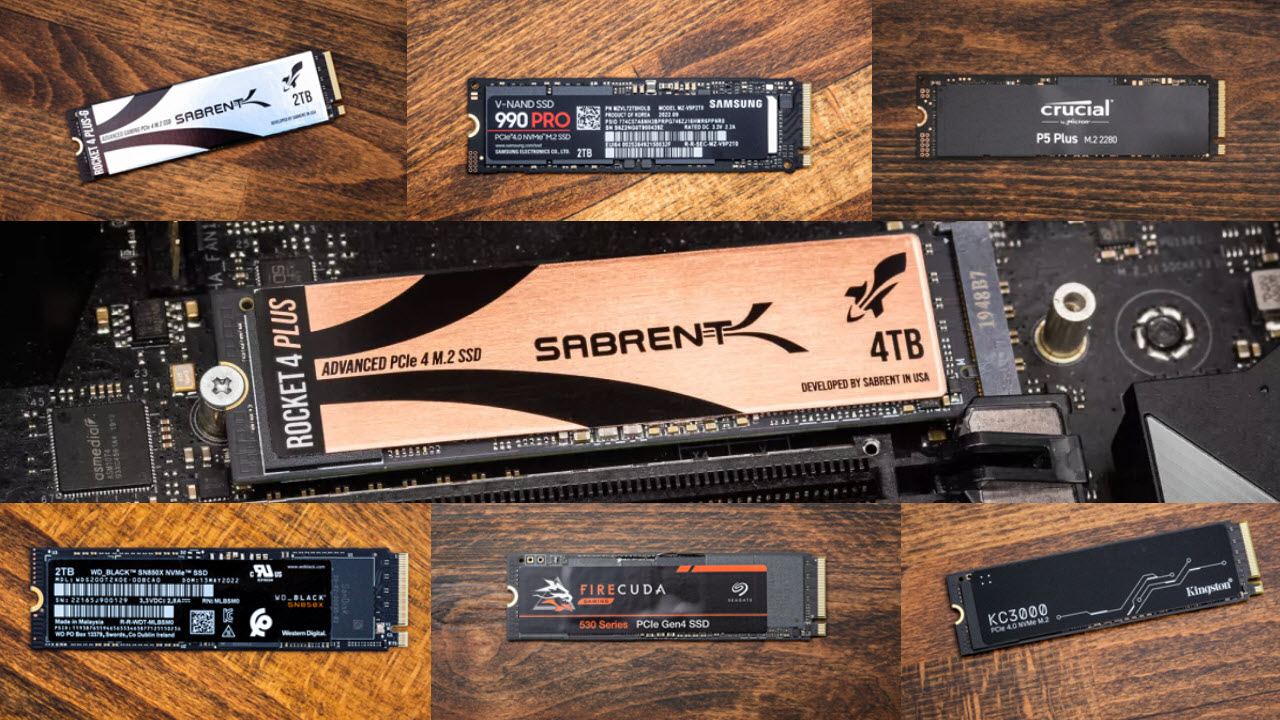
Nearly any new drive you buy for the PC can also be used in the PS5, so you’ll also find many of these same picks on our list ofBest SSDsfor desktop PCs. You can also use everything from a tiny M.2 2230 drive up to a longer M.2 22110 model in the PS5, but there’s no real benefit from choosing the other form factors. M.2 2280 SSDs are ubiquitous and typically offer the best combination of value, performance, and capacity.The PS5’s internal SSD is a restrictive 825GB (or 1TB on the PS5 Slim), and after formatting, updates, and bloatware, it typically leaves you with about 670GB free for games. That’s bad news because today’s games are becoming larger with each new release, and you’ll also need somewhere to store all the screenshots and video clips you gather while you play.Call of Duty,as an example, can use more than 200GB all by itself!The good news is thatSonyhas an M.2 expansion slot where you can put a second SSD for the PS5, and the current system firmware allows you to use SSDs with up to 8TB of capacity. That’s hopefully enough storage to satiate even the most demanding of gamers, but there are also far more affordable options, with modern 2TB and 4TB models being particularly attractive choices for the PS5.
SK hynix Platinum P41 2TB (Buy)
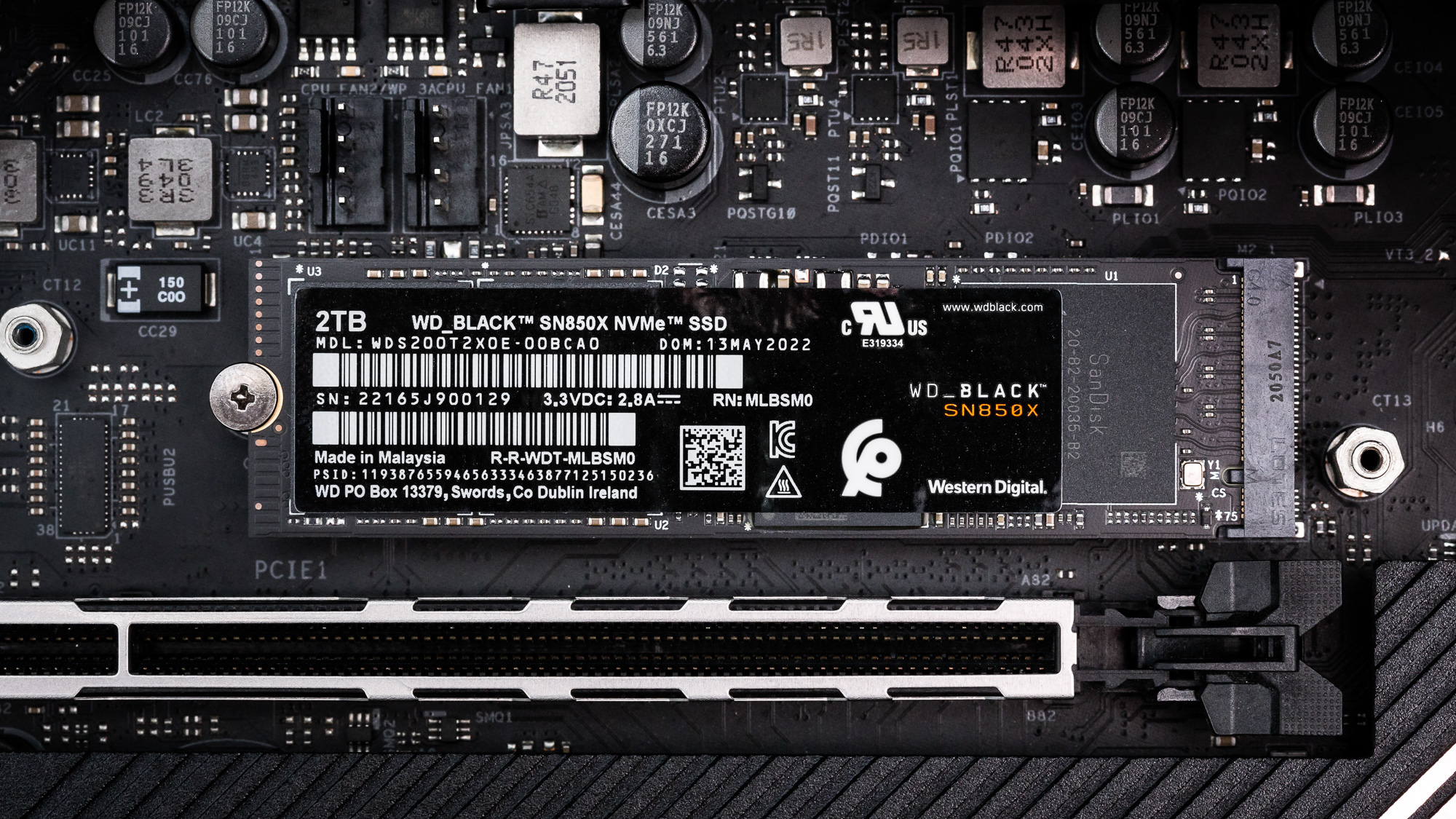
Samsung 990 Pro 2TB (Buy)
Samsung 990 Pro 4TB (Buy)
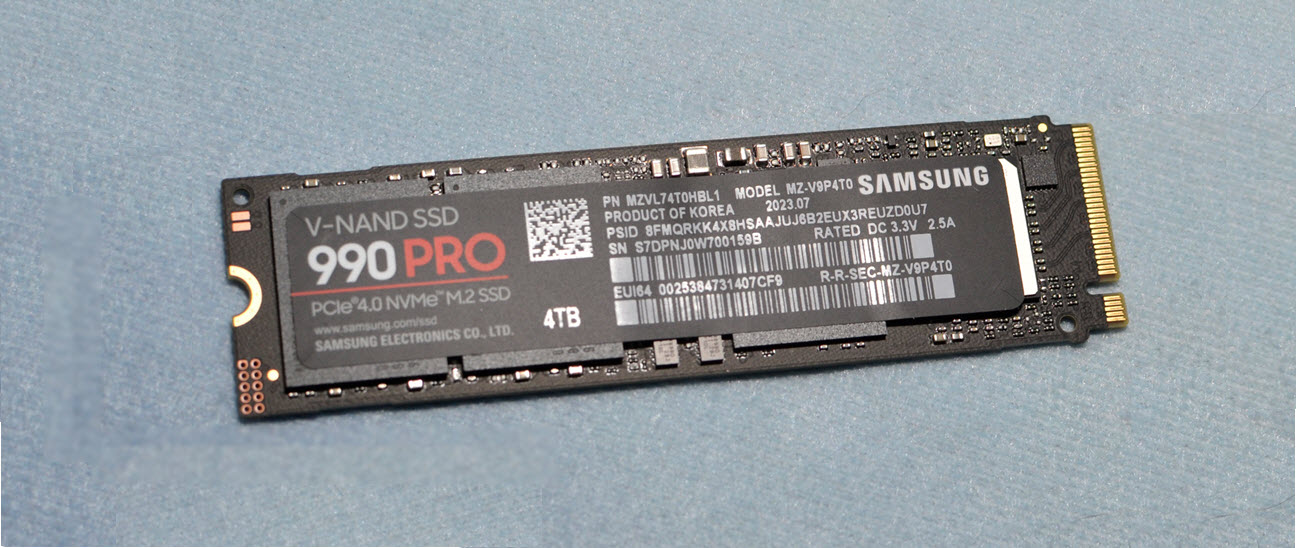
Silicon Power US75 2TB (Buy)
Netac NV7000 2TB w/ Heatsink (Buy)
Here’s the quick list of the best SSDs for the PS5, but we have further breakdowns and testing results below. There are also similar drives in some cases, with effectively the same hardware, and we’ll list those alongside our primary selections. When searching for the best SSD for the PS5, you’ll want to be careful about which drive you pick. TheSamsung 990 ProandWD SN850Xare great SSDs for the PS5, though pricing has been trending upward for the past several months — on all SSDs. The SN850X also comes as anSN850P that’s just an overpriced SN850Xwith a different heatsink and PlayStation 5 branding.We’ve broken things down by category, with our top picks being theWDBlack SN850X, SK hynix Platinum P41, and Samsung 990 Pro. For capacity or budget minded shoppers, we also have the Acer GM7000, Silicon Power US75, and Netac NV7000. Which drive will fit your particular needs best depends on what you’re after, so we list multiple alternatives for most categories and SSDs.
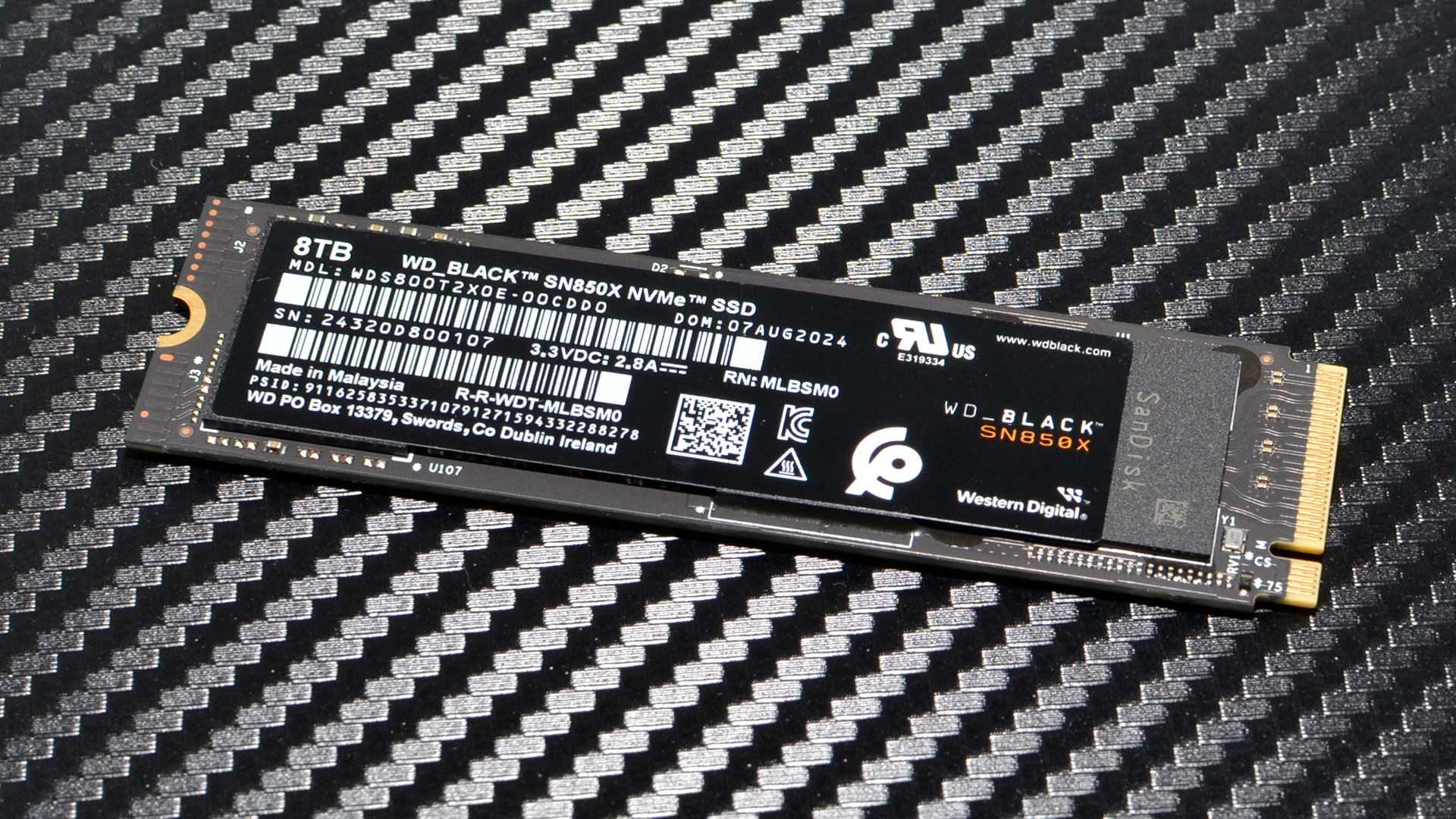
Reasons to buy
Reasons to avoid
WD took its popular Black SN850 SSD and turned it up to 11, but luckily the price isn’t nearly so extreme. The current$124 price on Amazon for the 2TB modelis a great deal, though other capacities may not be as attractively priced. The4TB drive at $249is worth a look for those who want more capacity; the8TB drive at $549is also worth a thought if youreallywant all the capacity you may pack into that M.2 slot — and it’s now $300 off the original launch price.The Black SN850X leverages an improved controller and newer flash to get the most out of the PCIe 4.0 interface, thus delivering excellent performance with the Sony PlayStation 5. Performance is improved across the board, and the drive comes with a heatsink option at all capacities. You’d be better served by a purpose-built PS5 heatsink, however.WD also supports the SSD with a respectable five-year warranty that will let you game with peace of mind. It’s a great match for the PlayStation 5, and while it can be a bit pricier than budget options, overall it’s still our top pick. It’s also fast for gaming on a PC, particularly with DirectStorage starting to become useful.WD has taken the course of releasing an officially-licensed SN850P. That drive is aglorified heatsinked SN850Xand should only be picked if you really want the PS5 logo on your heatsink for whatever reason. It’s far less expensive to get a bare SN850X andadd your own heatsink.Read:WD Black SN850X Review,WD Black SN850X 8TB Review
The Samsung 990 Pro was not our original pick for the best PS5 SSD alternate option, but the drive has grown on us over time. Samsung experienced some firmware issues with the 990 Pro that were eventually resolved, and the manufacturer later introduced a single-sided 4TB SKU with newer flash to enhance the product. This newer flash has trickled back into the smaller SKUs, making the mature version of this drive an excellent all-around pick. That means it’s great for the PlayStation 5 even though it lacks the 8TB option that WD/SanDisk offers with theSN850X/SN850P line.
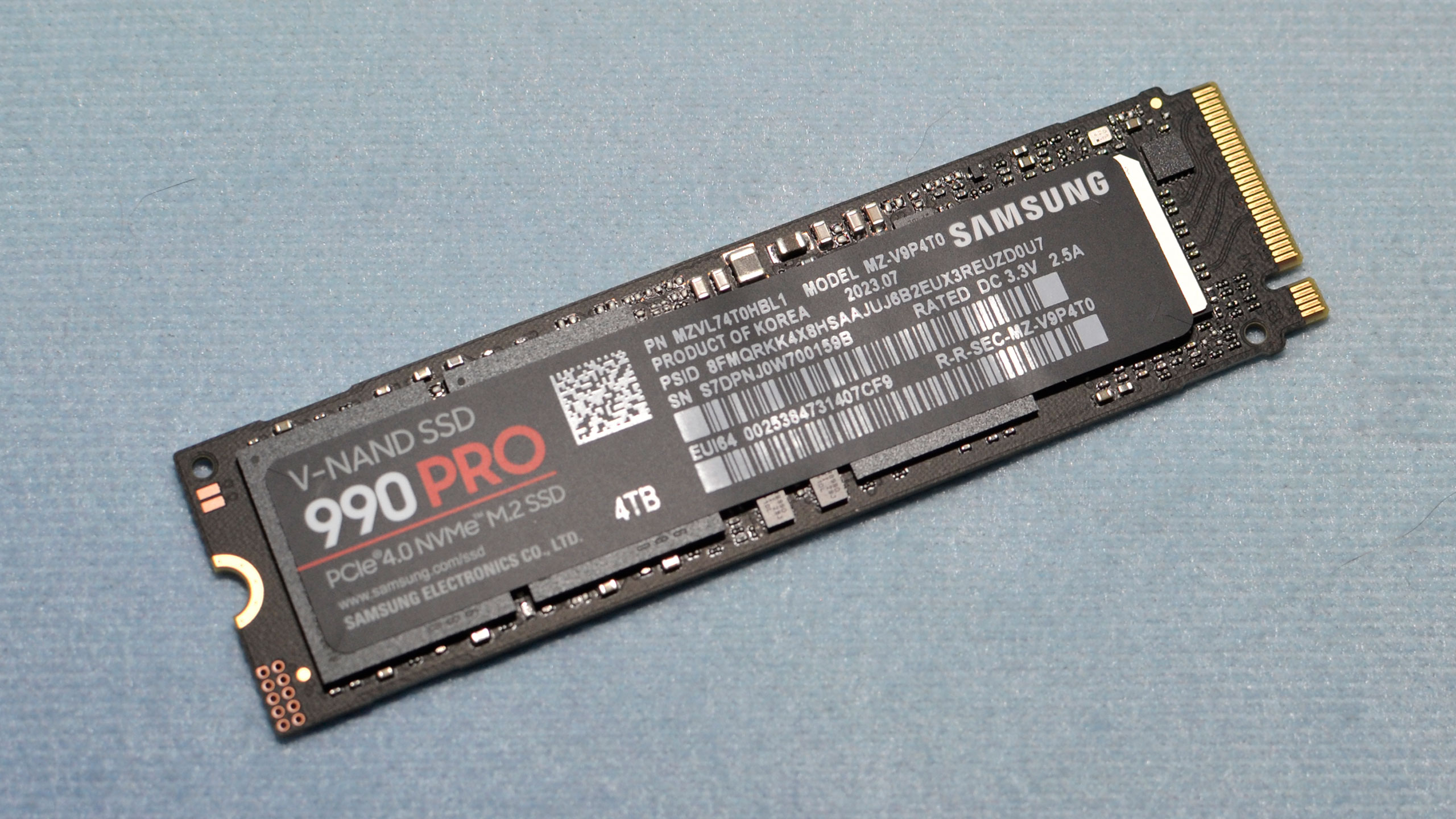
Samsung also offers the drive with a PS5-compliant heatsink, which means one less worry if you’re running your system hard in a hotter environment. you’re able to also take advantage of Samsung’s software and support if you have a PC available to host the drive. The main downside of the 990 Pro, especially when it’s being used for the console, is that it costs more per GB than many alternatives on the market. If you want a high-quality drive, though, it’s near the top of our list.
If you want the largest possible SSD for your PS5, look no further than the WD Black SN850X 8TB. 16TB drives aren’t really a thing in the consumer space, likely because even 8TB drives remain relatively niche parts with a higher price per TB of capacity than 4TB and 2TB drives. But the SN850X online prices have dropped quite a bit since it initially launched with an $849 MSRP.In our PS5 test suite, the SN850X 8TB was effectively just as fast as any other drive. The PS5 doesn’t support PCIe 5.0 speeds and the internal drive ends up being a bottleneck for both the copy to and read from tests that we run. That means you not only get maximum capacity but also maximum performance.What’s not to love? The price. $579 for 8TB isn’t terrible, but that’s more than a PS5 costs on its own. $649 for the heatsink version is a bit of a joke, since you can put on your own $10–$15 heatsink instead (but without the WD Black branding). It’s also a double-sided drive, which means the underside can run a bit hotter if you’re doing a bunch of writes — both most writes will be limited by the internet connection so it’s not really a concern.
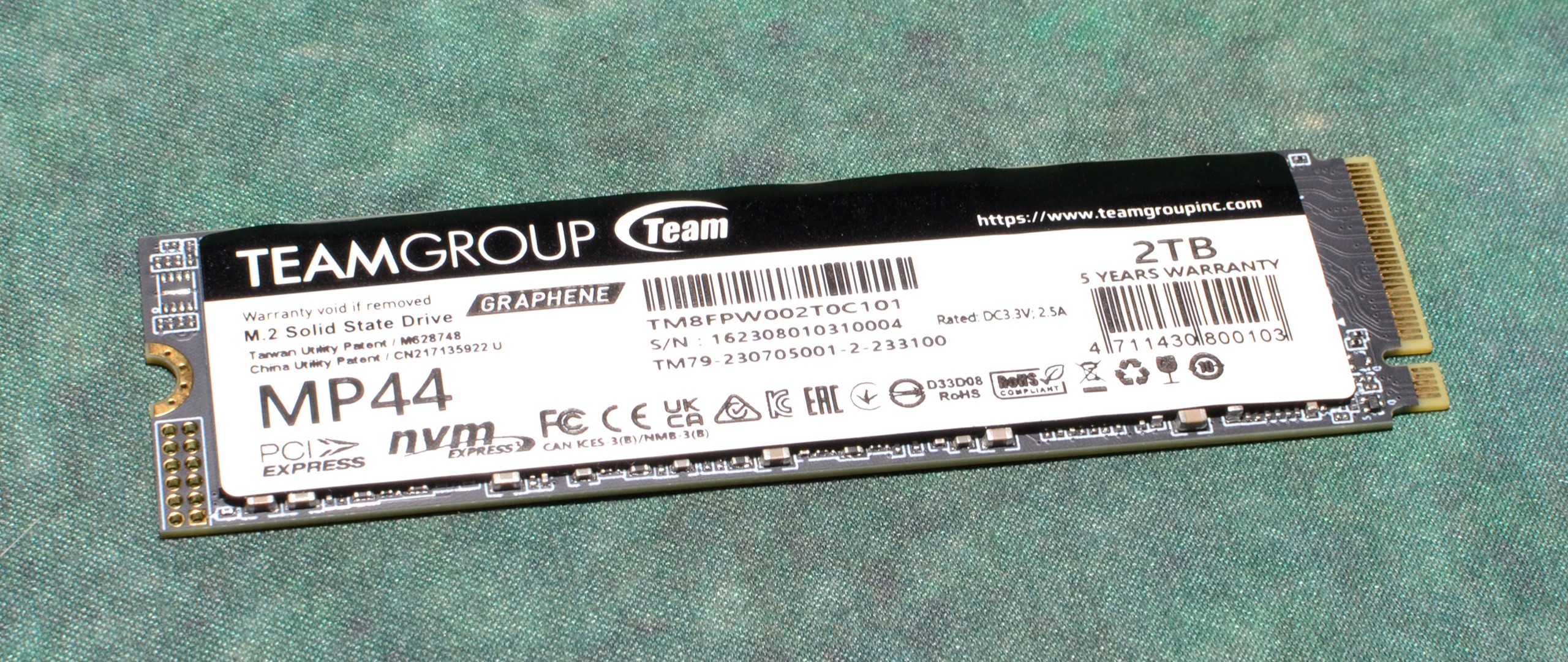
The Samsung 990 Evo Plus takes the same Piccolo controller found in the 990 Pro and pairs it with newer, higher capacity 236-layer (v8) V-NAND. Performance ends up being very good, particularly if you’re planning on putting it into a PS5, and you can get up to 4TB of capacity in a single-sided drive.
Samsung is also about as well-known and reliable an SSD brand as you’re able to find. There have been issues with a few models over the years, but the 990 Evo Plus has so far been free of any notable problems. Whether it’s in a PS5, laptop, or desktop, the 990 Evo Plus is efficient and fast.While our primary capacity pick has double the storage, for many 4TB of storage in a PS5 will be “enough” to hold a sizable gaming library.
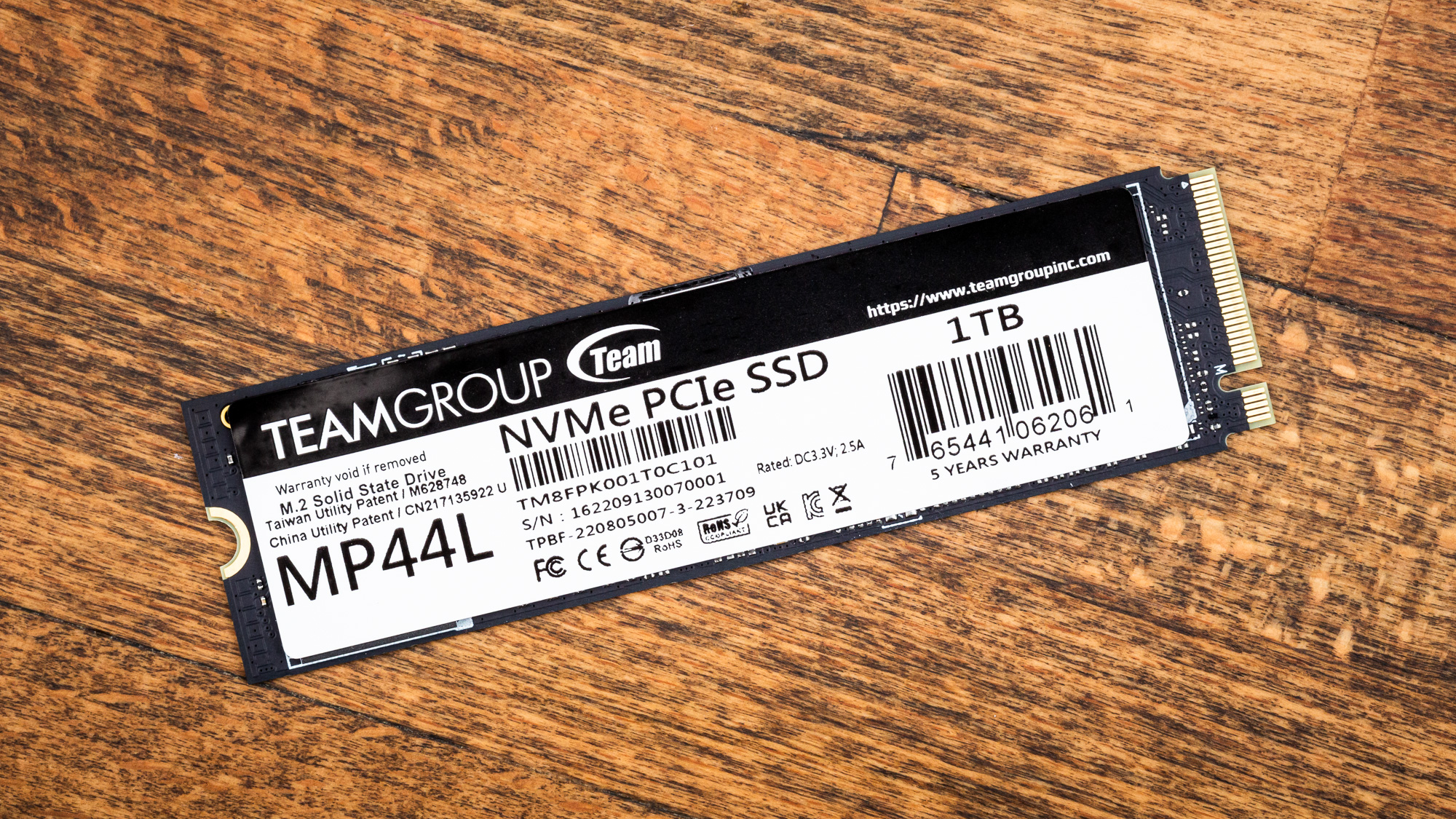
The Teamgroup MP44 is, and has been, one of our favorite budget drives. This is true for desktops, laptops, and the PS5. It tends to be competitive at most capacities with a wide capacity range, and in our review it performed very well in general with plenty of performance for this console. There are many decent competitors, like thePatriot Viper VP4300 Lite, the MSI M482 at 2TB, and our old choice for this category: theSilicon Power US75. All of these including the MP44 are DRAM-less, but that’s not a big deal for gaming.So, why the change? Well, unfortunately, many models will change hardware over time and often not for the better. There have been reports of QLC flash on the VP4300 Lite and US75, to name two, but the MP44 has stuck with TLC flash so far. This doesn’t mean the hardware hasn’t changed on the MP44 — an alternative controller to the Maxio MAP1602, the Phison E27T, has been reported, as has different TLC flash — but the drive still largely performs as tested and expected. This means good performance and high power-efficiency, to the point where you might not even need a heatsink.Read:Teamgroup MP44 review
The Teamgroup MP44L is another one of our favorite budget SSDs and, like the MP44, it’s replacing a drive formerly on this list. In this case it’s replacing theNetac NV7000and for similar reasons: the NV7000 has multiple hardware configurations, including some with the InnoGrit IG5236 controller that has had reliability issues. The MP44L is far from perfect as it’s slower than the NV7000 and is limited to 2TB, but on the other hand the availability of lesser capacities — and the fact it’s an inexpensive drive — makes it great if you have a very tight budget.The performance difference is there as the MP44L just barely meets the PS5’s criteria, but in real-world use your experience will be pretty similar among the various drives. You also get the benefits of better power efficiency and less heat production, which means it can be run without a heatsink. The MP44L is certainly starting to feel obsolete but the PS5 itself is entering its fifth year and the technology doesn’t really need more than an SSD of this caliber. There are certainly better drives and they can be found on this list, but if cost is your top priority you shouldn’t overlook this drive.Read:Teamgroup MP44L review
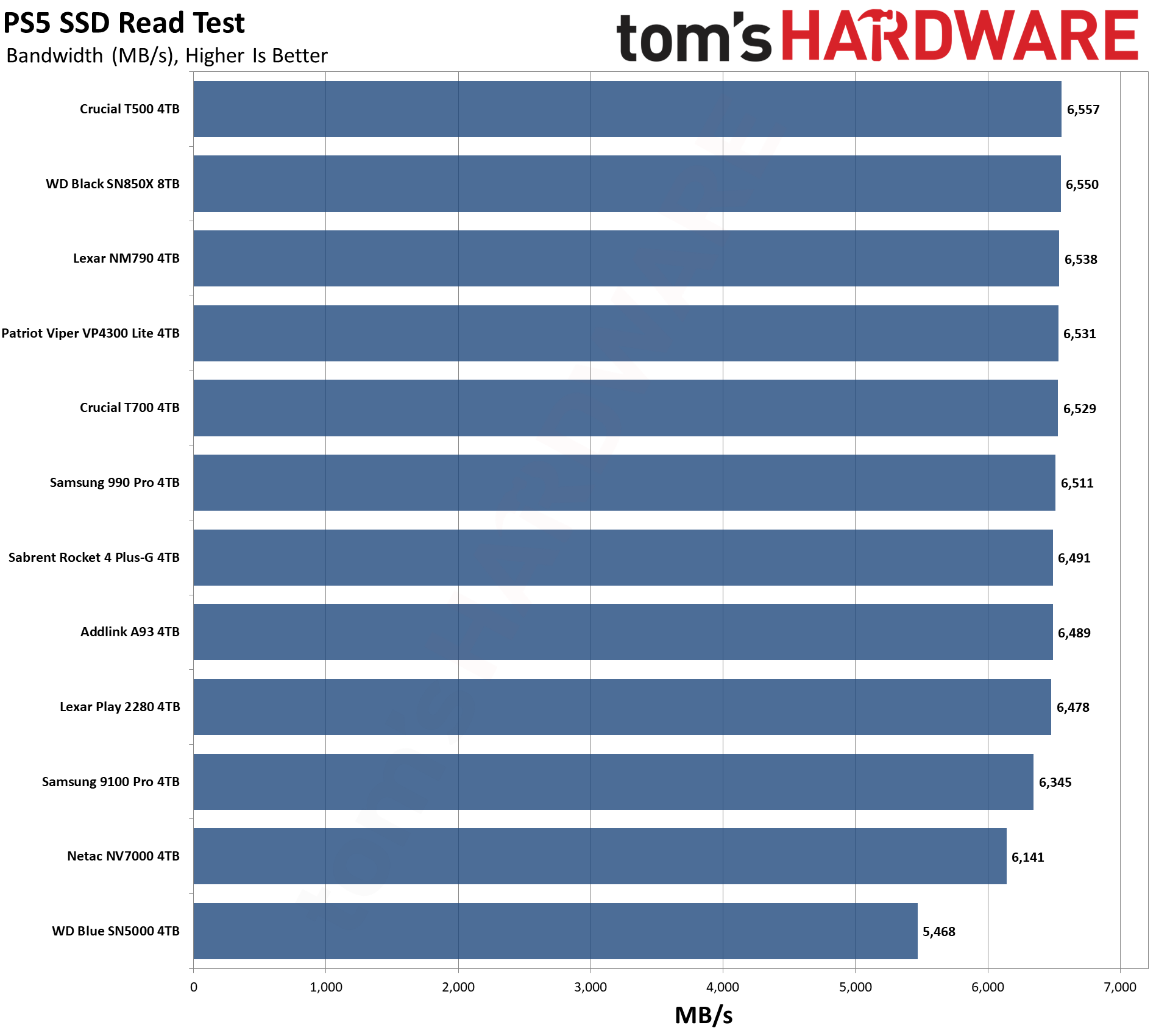
Swipe through the galleries for different capacities
Micron 4600 2TB
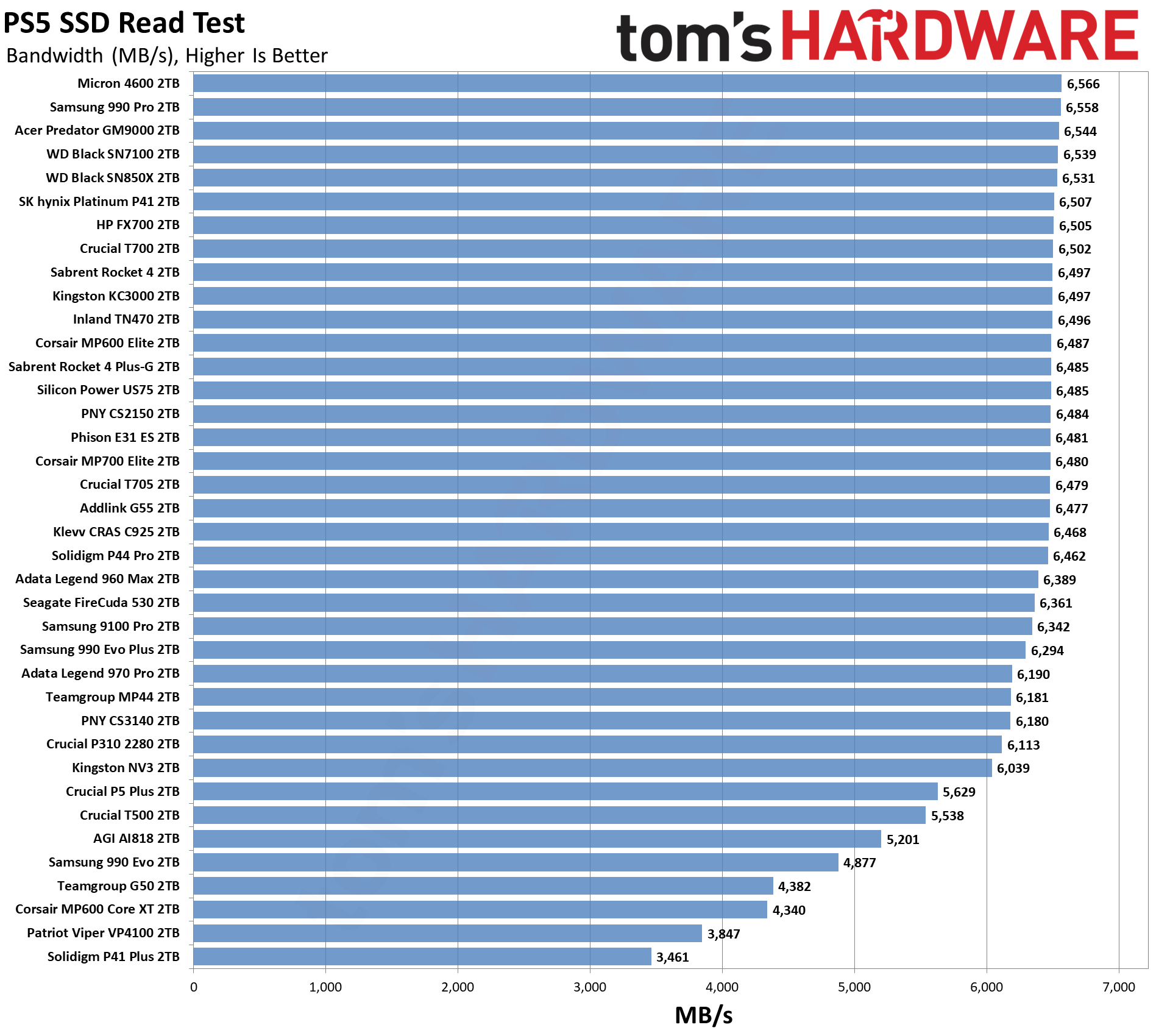
6,566
2,484
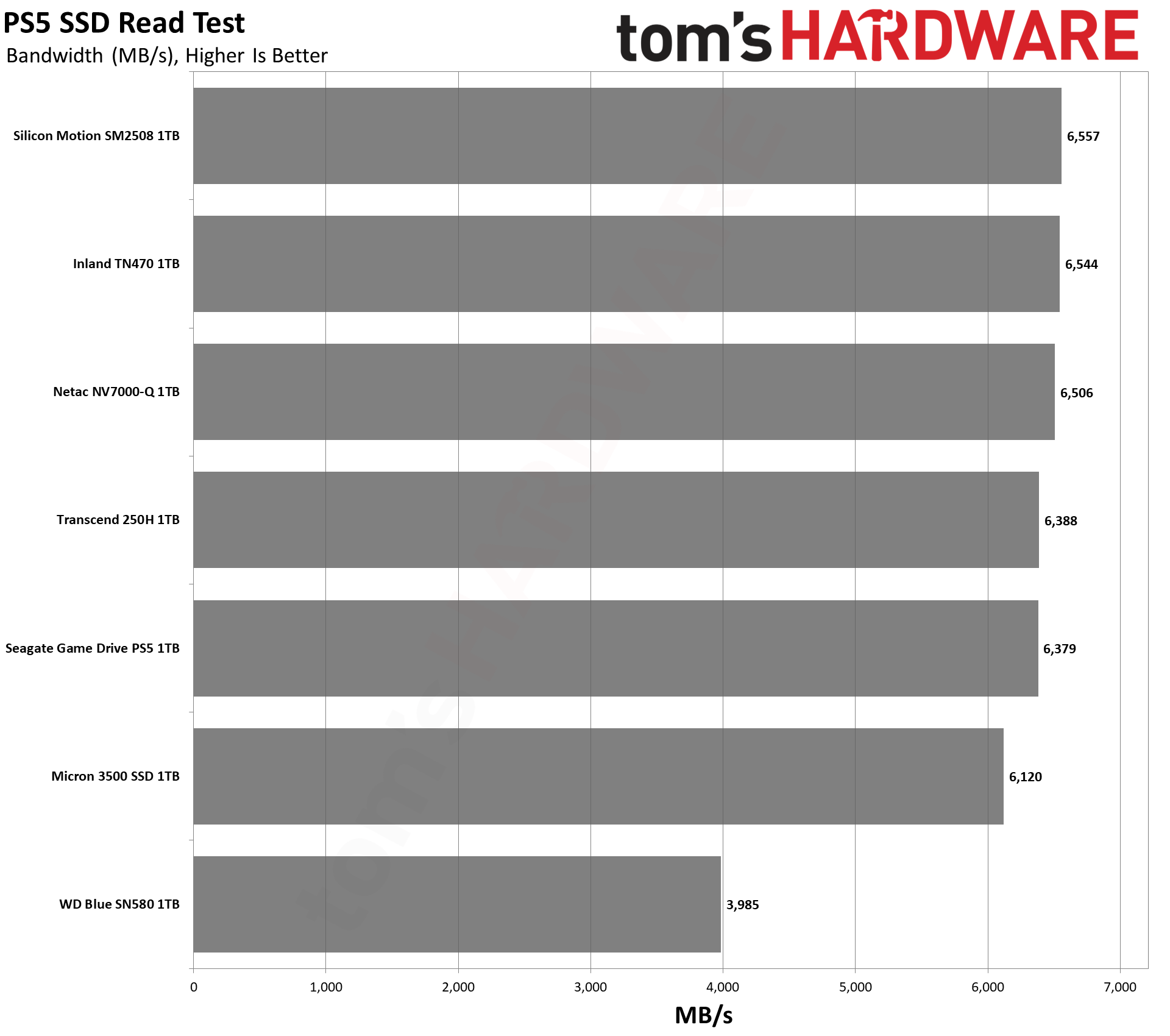
251.4
Samsung 990 Pro 2TB
6,558
2,495
252.2
6,557
2,402
249.7
2,302
238.9
6,550
2,490
243.7
6,544
2,455
251.7
901
251.2
6,539
2,449
6,538
2,327
249.9
6,531
2,329
249.5
250.2
6,529
2,390
Samsung 990 Pro 4TB
6,511
2,470
251.3
6,507
2,492
6,506
2,293
248.9
6,505
2,310
250.3
6,502
2,439
250.8
Sabrent Rocket 4 2TB
6,497
1,497
251.1
2,476
6,496
6,491
2,451
250.7
6,489
2,332
6,487
1,490
6,485
2,463
250.9
2,304
250.0
6,484
252.0
6,481
6,480
2,426
251.9
6,479
2,408
Lexar Play 2280 4TB
6,478
2,289
6,477
2,437
252.3
6,468
2,349
244.1
6,462
2,479
6,389
251.5
Transcend 250H 1TB
6,388
1,171
6,379
Seagate FireCuda 530 2TB
6,361
2,457
250.5
Samsung 9100 Pro 4TB
6,345
2,466
251.8
Samsung 9100 Pro 2TB
6,342
2,475
6,294
2,262
6,190
1,505
6,181
2,315
249.4
6,180
2,435
6,141
Micron 3500 SSD 1TB
6,120
2,405
250.6
Crucial P310 2280 2TB
6,113
2,379
251.6
6,039
2,361
5,629
2,448
5,538
2,378
250.4
5,468
2,372
247.5
5,201
2,375
Samsung 990 Evo 2TB
4,877
1,509
4,382
2,384
249.8
4,340
3,985
2,396
3,847
2,414
3,461
2,261
Some of the best SSDs for the PS5 are either specifically designed for the console, or come with an integrated heatsink. However, some drives don’t come with a heatsink, so we equip them with theSabrent M.2 NVMe heatsink for the PS5to both meet the requirements for the PS5 and to ensure a level playing field. We’ve found that this cooler is a great solution if you’re looking for a cheap, versatile, and easy-to-install solution. There are other similar heatsinks, like theSK hynix Haechi H01that will work just as well (though apparently neither of those work with the newer PS5 Slim).The Sony PS5 has an internal benchmark measuring how fast the system can read data from the drive. This is the most critical performance metric for gaming, as a speedy response time is responsible for ensuring a smooth gaming experience. As you can see in the ‘PS5 Read Benchmark’ column above, the fastest SSD in our test pool was 90% faster than the slowest model. Sony will even flag performance as being potentially inadequate if the read score is below about 4,000 MB/s. However, this read tests only takes a few seconds and basically shows the burst speed of the SSDs, so it’s quite synthetic in nature.Real-world tests show much smaller differences. For instance, our ‘Copy to M.2’ benchmark consists of timing how long it takes to move four games totaling more than 200 GB (we useMass Effect: Andromeda,Assassin’s Creed Valhalla,Elden Ring, andAstro’s Playroom) from the internal PS5 SSD to the expansion drive. In most cases, we only see a difference of a few seconds, and converting to MB/s the difference between the fastestWD Black SN850Xand theSolidigm P41 Plusis only 10%. But then there’s a pretty big step down to theSamsung 990 Evoand the various Phison E27T-equipped SSDs, followed by theTranscend 250H, and in dead last (for now) sits theInland TN470 1TB— another Phison E27T drive. How much will this matter in terms of gaming performance? Probably not at all, but when you move a bunch of data from the integrated SSD to the M.2 drive, it will take longer.On the flipped side, we also tested this process in reverse, moving the four games back to the internal drive for our “Transfer From M.2” benchmark. Here, the sustained write speed (and encryption/securityprotocols) of the integrated 825GB SSD becomes the limiting factor, and there’s only a 5.6% difference between the fastest and slowest SSD we’ve tested. The current 825GB SSD only appears to write data at up to ~250 MB/s, and all of the M.2 SSDs are easily able to maintain read speeds much higher than that figure.Likewise, real-world testing (i.e. launching games) has failed to expose meaningful differences between the drives — it’s common to see at most a one to two second difference between drives in game load times. Other testing we’ve seen from multiple outlets indicates very few meaningful differences, if any, for game loading times. Overall, you’re unlikely to notice the speed difference between most PCIe 4.0 SSDs and could make a good argument for simply selecting the most cost-effective drive that meets the capacity target that you want — 4TB and 2TB drives are particularly popular.Naturally, not all of the drives that we test will make the final cut for our list of Best SSDs for the PS5, but that doesn’t mean those drives failed the test, or wouldn’t be a great deal if you can catch them on sale. TheSolidigm P44 Prois a great SSD that delivered respectable performance in our PS5 SSD benchmarks (it’s the same hardware as theSK hynix Platinum P41), and given the slim difference between the fastest and slowest SSDs on our list, it could make a great drive if the price is right. The only thing we’d attempt to avoid is any SSD that uses QLC NAND, as those drives can slow down significantly as they’re filled to capacity.There’s also no real benefit at present to selecting any of the PCIe 5.0 SSDs, as they tend to use more power then PCIe 4.0 drives, making them a poor choice for the PS5. Given current prices there’s no real purpose in using a PCIe 5.0 drive for your PlayStation 5, though we’ve included results from several of the newer models (on the assumption that price differences between PCIe 4.0 and 5.0 drives will shrink over time).
Tips for Finding the Best SSD for the PS5 in 2024
Which SSDs are compatible with the PS5?Luckily, finding a spacious PS5 SSD to complement your console’s internal drive isn’t too difficult — any PCIe 4.0 SSD that provides a minimum of 5,500 MB/s of throughput over the NVMe interface can be used as a PS5 SSD, provided it comes with a heatsink that doesn’t take the overall height above 11.25mm. In fact, even slower SSDs will also be perfectly fine (PCIe 4.0 is still required), though the PS5 may warn you about the potential for reduced performance if you opt for such a drive.Do you absolutely need a heatsink for a PS5 SSD?Sony says yes, and you can easilyadd your own heatsinkto SSDs that aren’t marketed specifically for the PS5. You can also use one of thebest external driveswith the PS5 to store games, but these are only for game storage — you’ll need an internal expansion drive to actually play the games.What size of SSD should you buy for the PS5?You might be fine with a 1TB drive, but we recommend selecting a 2TB or 4TB model due to the current low pricing trends for these models. Besides, who wouldn’t want more storage for extra games?Ultimately, the best drive for your PS is one that provides enough capacity to hold your games and data at a price you can afford. To help you choose, we’ve tested a number of the top SSDs in our labs — see the results further down the page — and pulled out the top performers for a list of the Best PS5 SSDs.
Sony PS5 SSD Requirements
The Sony PS5 requires an M.2 SSD that communicates over the NVMe protocol. Officially, you’ll need a PCIe 4.0 x4 model that can deliver up to 5,500 MB/s of sequential read throughput. In practice, you can use slower SSDs, and you’ll just get a warning that performance may be inadequate — note that PCIe 3.0 models are explicitly prohibited from working. The console supports 250GB, 500GB, 1TB, 2TB, 4TB and 8TB models.These small, rectangular drives look like sticks of RAM, only smaller, and the PS5 accepts both single-sided and double-sided versions. You’ll also need to ensure that your drive has a cooling solution pre-applied. These can consist of thin copper heat spreaders that look like a label, or a full-fledged metal heatsink with a thermal pad.Not all of the best SSDs for the PS5 come with a heatsink, but you can easily use your own double- or single-sided heatsink. We recommend theSabrent M.2 NVMe heatsink for the PS5, which actually replaces the outside SSD panel on the PS5 with a heatsink, giving the SSD access to nice cooler air from outside the system. We’ve found that this cooler is a great solution if you’re looking for a cheap, versatile, and easy-to-install solution, but there are many options on the market. For instance,TeamGroup has its new TForce AL1 heatsink, which operates similarly, coming to market soon.Just make sure the SSDs don’t exceed 110 x 25 x 11.25mm. M.2 SSDs are usually 80mm long by 22mm wide, described as size 2280, but some may be shorter or longer. The PS5 supports M Key Type 2230, 2242, 2260, 2280 and 22110. Some M.2 drives are also SATA interfaces instead of NVMe, but those are rare and would not be listed as being PCIe 4.0 compliant. Regardless, make sure your SSD supports NVMe.
Sony hasdetailed instructions on how to install a PS5 SSD. As you can see in the video above, installing the SSD is a simple process that only requires a #1 Phillips head screwdriver. After you’ve installed the SSD, you can navigate through the menus to the ‘Settings→Storage→Installation Location’ area and change it to your new SSD. All new games will now install directly to the SSD.To move existing games to your new drive, select the internal SSD, highlight the item you want to move, press the Options button, and then select ‘Move Games and Apps.’ Select any other games that you would like to move in the checkboxes, then select ‘Move.’ As noted in our above testing, movingfromthe integrated SSD will generally be much faster than movingtothe integrated drive.
Get Tom’s Hardware’s best news and in-depth reviews, straight to your inbox.
Jarred Walton is a senior editor at Tom’s Hardware focusing on everything GPU. He has been working as a tech journalist since 2004, writing for AnandTech, Maximum PC, and PC Gamer. From the first S3 Virge ‘3D decelerators’ to today’s GPUs, Jarred keeps up with all the latest graphics trends and is the one to ask about game performance.